Pengujian Blackbox pada Aplikasi Penyimpanan berbasis Android menggunakan Teknik Boundary Value Analysis
 Abstract views: 127
,
Abstract views: 127
,
 PDF (Bahasa Indonesia) downloads: 163
PDF (Bahasa Indonesia) downloads: 163
Abstract
Mobile app or commonly known as an application on a smartphone is one of the businesses that is currently being developed by many people to meet human needs in many ways. Mobile apps are very widely used because they are easy and almost everyone in Indonesia already has a smartphone. Of the various applications made to facilitate human work, one of which is the application of inventory or storage and recording related to assets or goods that are very important in an organization or company so that in the development of their business they can be analyzed at any time. However, every application creation cannot be separated from testing the application to overcome errors that occur when the application is used. To overcome and look for bugs and errors contained in the application, a test was made on the storage application using the black box testing method with the boundary value analysis (BVA) technique. BVA is one of the tests to find errors in applications from the user's point of view by testing the limit values at the upper and lower limits with the stages of identifying problems, selecting test data, test data, testing using boundary value analysis and also documentation. The results of the study using boundary value analysis as a whole have a success percentage of the application after testing is 5:1 with a success rate of 83.33%.
Copyright (c) 2021 Journal of Innovation Information Technology and Application (JINITA)

This work is licensed under a Creative Commons Attribution 4.0 International License.
Authors who publish with this journal agree to the following terms:
- Authors retain copyright and grant the journal right of first publication with the work simultaneously licensed under a Creative Commons Attribution License that allows others to share the work with an acknowledgement of the work's authorship and initial publication in this journal.
- Authors are able to enter into separate, additional contractual arrangements for the non-exclusive distribution of the journal's published version of the work (e.g., post it to an institutional repository or publish it in a book), with an acknowledgement of its initial publication in this journal.
- Authors are permitted and encouraged to post their work online (e.g., in institutional repositories or on their website) prior to and during the submission process, as it can lead to productive exchanges, as well as earlier and greater citation of published work (See The Effect of Open Access).
















